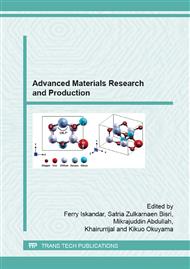p.367
p.373
p.377
p.381
p.385
p.389
p.393
p.397
p.402
Dynamic Mechanical Properties of PEG 4000 + Quartz Composites
Abstract:
The complex shear modulus of polyethylene glycol (PEG) 4000 + quartz compositesas a variation of processing temperature and applied temperature has been investigated using a Dynamic Mechanical Analysis (DMA) instrument. The quartz, obtained by processing silica sand from Tanah Laut, South Kalimantan, of as much as 40% by weight was used as the filler of the composite. The processing temperature was room temperature, 50°C, and 70°C after considering the theoretical melting point of PEG 4000. Results showed that such temperaturesgave several phenomena related with the complex modulus values from the pure PEG 4000 and the composite, i.e.they dropped with time indicating the presence of relatively rapid strain relaxation and were in the range of 50-300MPa. Furthermore, theaddition of quartz improved the values wherethe most improvement occurred on the 70°C sample,i.e. almost twice from the pure PEG 4000. Increasing the heating process, however, significantly reduced the values. The reduction was confirmed by further investigation where the result showed that the complex shear modulus value both in the pure PEG 4000 and the composite dropped with applied temperature at around 42°C and 45°C, respectively, whichcan be related to the melting PEG. A severe drop was particulartly observed in the composite which was believed caused by the addition of quartz in a lose powder form.
Info:
Periodical:
Pages:
385-388
Citation:
Online since:
July 2015
Price:
Сopyright:
© 2015 Trans Tech Publications Ltd. All Rights Reserved
Share:
Citation:


